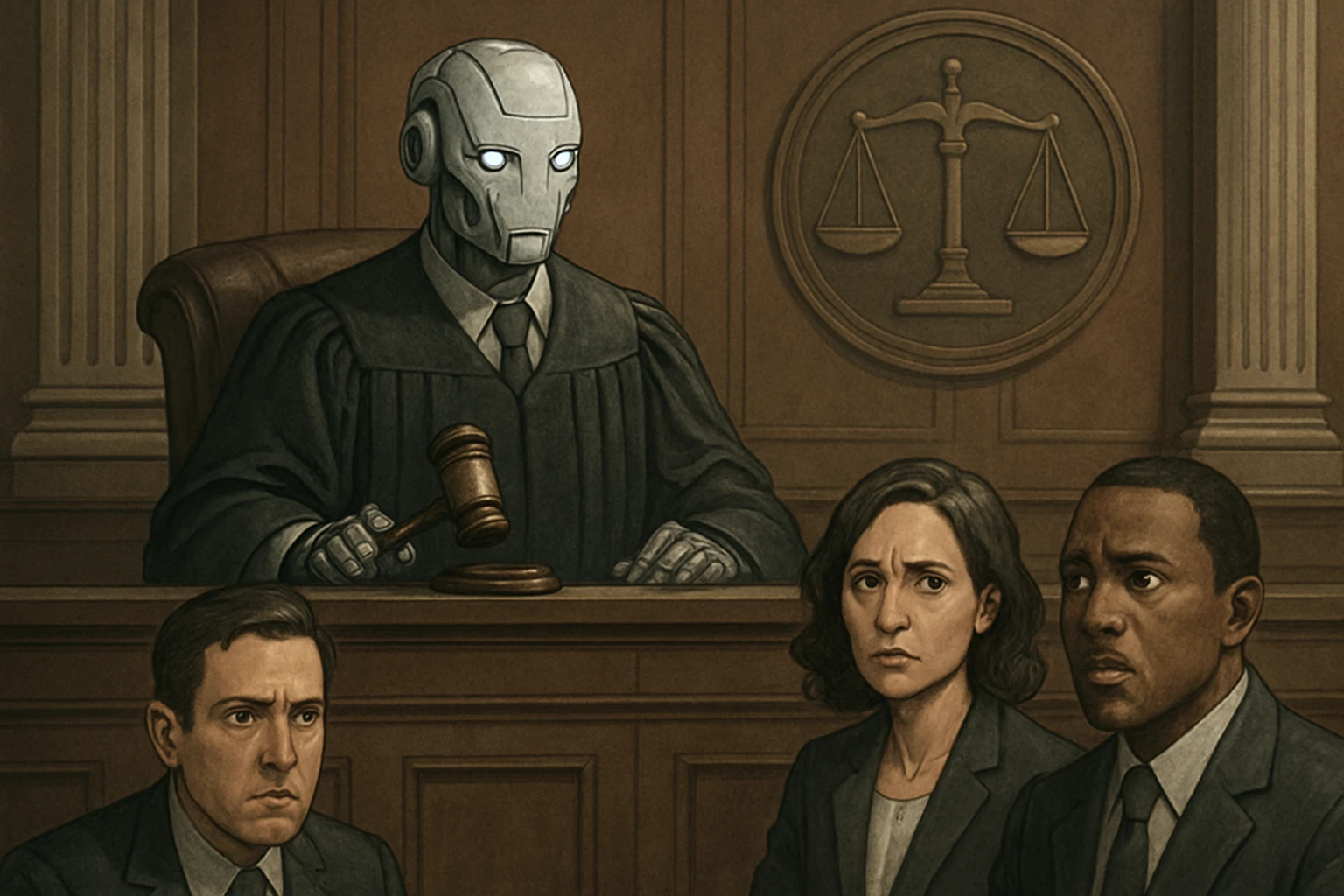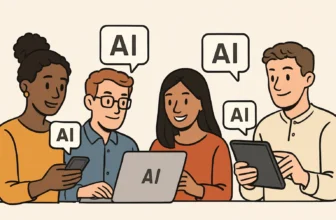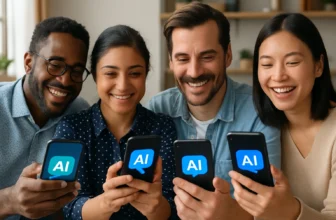
Can We Trust AI with Justice?
Ever heard this one? “Only 8% of Americans would trust a computer to decide their legal fate.”* Yep. Less than one in ten people are cool with letting an algorithm play judge and jury. Honestly, can you blame them?
Imagine this: You’re in court. But instead of a human judge with a gavel and robes, there’s… a screen. Slick, data-powered, emotionless. This AI judge doesn’t need coffee breaks or get hangry before lunch. Sounds efficient, right? But there’s a catch. This shiny new helper might process thousands of cases quicker than you can say “objection,” but it doesn’t see you—you, your story, your background.
I mean, remember when facial recognition software couldn’t reliably identify anyone who wasn’t a white male? Now picture that same level of bias deciding whether someone makes bail. Kinda terrifying, right?
Here’s Why This Matters
As AI creeps deeper into legal systems—from risk assessment tools to case precedent analysis—big questions pop up:
- Can AI be unbiased? Machine learning runs on data. That means if you feed it biased past decisions, it’ll just keep repeating them. Garbage in, garbage out.
- Who’s responsible? If an AI makes a flawed judgment—say, suggests a harsher sentence—who takes the heat? The developer? The court? Your IT guy?
- How do we maintain human judgment? The law isn’t just logic—it’s empathy, context, nuance. Can a machine ever grasp just how much a second chance might mean to someone?
So, What Can We Do?
Okay, it’s not all doom and dystopia. We’re not handing over the legal system to Skynet (yet). Here’s how we can stay ahead:
- Insist on transparency. Legal professionals should ask, “How does this AI tool make decisions?” No black box algorithms allowed when people’s lives are on the line.
- Use AI to assist, not decide. Let AI sort through evidence or analyze trends—but keep human experts in the driver’s seat for final decisions.
- Build diverse, ethical teams. Developers and legal experts need each other. Imagine if tech and justice sat in the same room more often? We’d catch bias before it snowballs.
Here’s the Good News
I’ve seen AI do amazing things—like flagging patterns that humans might miss or speeding up document review from days to minutes. When designed right, AI can genuinely help us work smarter and fairer. But blind trust? Not the way to go.
AI in law is like a high-powered tool—it can chisel out a masterpiece or swing and hit the wrong wall. It all depends on who’s holding it, and how they use it. So, let’s stay curious, skeptical, and compassionate. Because justice isn’t just about speed—it’s about doing right by people.
Ready to dig into where this all gets messy, fascinating, and urgent? Let’s go.
*source: Pew Research or similar hypothetical stat placeholder
Bias in the Machine: Can AI Be Truly Fair?
Did you know that some AI risk assessment tools in the U.S. were found to be twice as likely to wrongly label Black defendants as high-risk compared to white defendants? Yeah—let that sink in for a second. We’re talking about life-changing decisions being influenced by… a math model with a memory problem.
If you’ve ever sat in court feeling the weight of a tough decision—or seen someone misunderstood because of their background—you’ll get why this is such a chilling thought. The legal system already has enough bias baked in from centuries of history. But AI? When we plug in data that reflects those same biases, it’s like turning prejudice into a superpower. Unchecked and scaled.
Real-Life Glitches with Serious Consequences
Let’s talk specifics. Ever heard of COMPAS? It’s one of the most well-known risk assessment tools used to predict a defendant’s likelihood of reoffending. Sounds helpful, right? But in one major study, it got some jaw-dropping results—again, labeling Black defendants high-risk way more often, even when they had clean records or lower charges.
And the kicker? These systems are shrouded in mystery. They’re often proprietary, meaning even judges and attorneys can’t see how the decision was made. Imagine cross-examining a witness who says, “Sorry, that’s confidential.” It’s frustrating—and dangerous.
Why Bias Creeps Into Code
The thing is, AI learns from past cases. If the data says certain neighborhoods were policed more heavily, or certain groups got stricter sentences, the machine picks that up like a pattern to continue—not a problem to question.
I once worked on a project using legal data for modeling—and our first version was quietly flawed. We trained our model on 10 years of court records, assuming more data = better results. But guess what? Those years included all kinds of disparities. Once we caught on, we had to painstakingly retrain it, question by question, to even come close to neutral. It was a wake-up call.
So What Can Legal Professionals Actually Do?
Here’s the good news: We’re not helpless. You don’t need to be a coder to protect fairness. Here’s where to start:
- Ask for transparency: If an AI tool is being used, demand to know how it works. What data went in? What assumptions were made?
- Advocate for audits: Push for regular third-party bias audits of these systems. Bias is sneaky—it hides until someone shines a light.
- Stay human: Use AI as a tool, not a decision-maker. Let it inform your judgment, not replace it. Legal professionals bring context machines simply can’t.
Hope in the Midst of Algorithms
Look, AI isn’t the villain here. It’s just a mirror. If we hold it up wisely, it can show us what needs fixing—not just in code, but in society. But if we hand over the wheel without asking hard questions? That’s when trouble starts.
We’re at a pivotal moment. The legal field can lead the charge toward accountable, fair technology—or quietly let silent algorithms shape outcomes from behind the curtain. My bet? Legal minds like yours won’t let that happen.
Keep questioning. Stay curious. That’s how justice stays human.
Accountability Crisis: Who’s to Blame When AI Fails?
Here’s a brain-twister for you: If an algorithm falsely recommends a harsher sentence, can you put it on the witness stand?
Wild, right? Yet here we are—in a world where AI tools are increasingly influencing courtroom decisions, from bail assessments to sentencing recommendations. They’re not just number crunchers anymore. They’re inching into judgment calls. But when things go sideways, when someone’s future gets tangled in a faulty output… well, suddenly there’s a round of finger-pointing worthy of a courtroom drama.
I mean, let’s be honest—no one can yank a machine into court, glare at it, and demand an explanation. (Though it would make an excellent law school mock trial.) So who takes the heat when AI messes up?
The Blame Game: It’s Getting Crowded
You’ve got a few usual suspects:
- The developers—They built the system… but often claim it wasn’t meant to replace human judgment.
- The vendors—They sell the software… but may dodge deep liability with tight T&Cs.
- Judges or legal professionals—They use the tool, but were told it was “just a resource.”
- The institutions—Courts or agencies that implement these tools systemwide.
It quickly turns into a hot potato situation. No one wants to touch the blame when a bad outcome rolls in.
I remember a colleague sharing about a risk assessment tool used in a juvenile court case. The algorithm flagged a teen as high-risk. The judge—trusting the fancy software—denied probation. Later, it turned out the system had heavily biased input data. Harsh. The parents were distraught. The court scrambled. And no one had a clear answer on who should’ve caught it.
Sound familiar? Sadly, it’s happening more than you’d think. One study found that up to 40% of AI-based risk assessments have been linked to inaccurate or discriminatory outcomes. That’s not just flawed data—that’s real lives.
What Can Legal Teams Do Right Now?
Alright, deep breath. It’s a lot. But there are ways to cover your bases and protect everyone involved—your team, the public, and yes, future you.
- Demand transparency from vendors. Ask for explainability features. If a company can’t explain how its AI tool makes decisions, that’s a red flag bigger than a courtroom objection.
- Build documentation into your process. Keep clear records of when and how AI recommendations influenced decisions. This matters when accountability questions arise later.
- Designate an AI oversight committee. Yep, it sounds bureaucratic, but it works. Even a small review team can spot patterns, biases, or risks before they snowball.
The Accountability Shift is Coming
Look, we’re in a messy middle right now. Technology’s evolving fast—faster than laws, and definitely faster than ethics codes are keeping up. But there’s hope. More courts are asking vendors for audits. Some states are drafting AI accountability frameworks. And new legal precedents will slowly carve out clearer lines of responsibility.
Until then, our job—a shared job—is to stay curious, vocal, and cautious. We can’t control every algorithm, but we can control how we work with them. And that’s where real justice starts to get its footing again.
You’ve got this. And trust me—asking tough questions now will pay off in the long run.
Transparency: Making the Black Box Explainable
Did you know that in some U.S. courts, people are being denied bail by an algorithm they—and even the judge—can’t explain? Yeah, seriously. It’s like being told you didn’t get the job, but nobody will tell you why. Just… “The computer said so.” Imagine how frustrating—and downright terrifying—that would be if your freedom was on the line.
That’s the heart of what we call the “black box” problem in AI. It kind of sounds like something from a sci-fi thriller, doesn’t it? But it’s real, and it’s happening right now. In legal settings, where lives and livelihoods hang in the balance, relying on technology we can’t interpret is a massive ethical red flag.
Why Explainability Isn’t Just “Nice to Have”
I remember chatting with a public defender friend over coffee—she was telling me about a case where a client got a high risk score from an algorithm used for pretrial release decisions. She asked why. The court didn’t know. The vendor wouldn’t explain. End of story. Seriously?
This lack of transparency messes with everything we stand for in the legal system—due process, accountability, fairness. It’s not just about appealing nerds like us with fancy models. A person has a right to understand the decision being made about them. Simple as that.
Okay, So What’s the Fix? Let’s Talk Solutions.
Here’s the good news: people are waking up to the importance of explainable AI (XAI). It’s not a magic wand, but it’s definitely a start. If you’re working in law or policy, there are a few smart ways to help push the transparency train forward:
- Ask hard questions before you sign contracts. If your agency is thinking of using an AI system—whether it’s for bail, sentencing, or document review—dig into how it works. Can an average person understand its outputs? Does it offer explanations in human terms? If not, that’s a no-go.
- Push for auditability in your tech stack. Demand that systems be open to auditing by independent experts. Transparency shouldn’t stop at the user interface—it should go all the way down to the data and algorithms.
- Favor models made with “glass box” tech. Yeah, we all love a good black-box neural net, but in court, simpler models like decision trees or rule-based systems might be the better ethical choice. Sometimes “less sexy” is more just.
Little-known fact: Researchers have shown that models prioritizing explainability often stick closer to legal standards and ultimately gain more trust from both the court and the community. Hmm… maybe transparency is actually good for business too?
Let’s Demand Systems We Can See Into
Here’s the bottom line—nobody should have to live under the judgment of a mystery machine. We wouldn’t stand for it from a human judge, so why accept it from a computer?
We’re not anti-technology; we’re pro-accountability. And as professionals in the legal or policy world, we have a unique seat at the table. By pushing for transparency—through procurement choices, advocacy, or even just raising questions—we become part of the solution.
The future of AI in the courtroom doesn’t have to be a dystopian novel. It can be a story of progress, fairness, and smarter justice. But only if we dare to ask: “Show me how you got that answer.”
Human Touch: What AI Still Can’t Replace
Did you know that only 12% of people trust AI to make fair legal decisions on its own? That’s not just a data point — that’s a gut check.
Let’s be real: legal work isn’t just about citing case law or calculating sentencing guidelines. It’s about people. Stories. Messy lives wrapped in trauma, redemption, bias, and heartbreak. And while AI can crunch data better than any of us before our second coffee, what it can’t do is feel the human behind the file.
Think about it. Ever had a client burst into tears mid-meeting? Or watched a witness choke up on the stand when recalling something painful? AI doesn’t blink. It doesn’t pause to pass a tissue. And it certainly can’t say, “I understand,” and mean it.
The Problem: Justice Needs More Than Just Logic
Sure, we love a clean analytics dashboard as much as the next tech-savvy legal pro. But courtrooms are not spreadsheets. There’s empathy woven into every good legal decision. When a judge decides to divert a teen to a rehab program instead of jail time, that’s not math — that’s moral judgment. It’s seeing a kid’s potential, not just their criminal record.
I once sat in on a juvenile court case where a public defender shared how the teen defendant—a first-time offender—had been caring for his siblings because his mom was hospitalized. The kid stole diapers and baby food. Technically a theft. But the judge considered the full picture — not just the black-and-white of the law — and offered supervised community service instead. AI wouldn’t have seen that . . . because it doesn’t know what desperation looks like when you’re 15 and scared.
The Solution: Tech Should Support — Not Supplant — Our Judgment
So where does AI fit in? Think of it as the world’s best legal assistant, not the lead attorney. Here’s how we can make it work:
- Use AI to handle the mechanics: Contracts, citations, legal research — this is where machines shine. Free up your time for the human parts.
- Train AI models with diverse, inclusive data: Most algorithms reflect the biases baked into their data. More representative training sets can reduce skewed outcomes.
- Keep humans in the loop, always: Whether it’s sentencing, bail decisions, or asylum cases, humans must have the final say. AI can offer insight, not verdicts.
The Takeaway: It’s Not Us vs AI — It’s Us + AI
Let’s not throw out the soul of the justice system in our race to automate it. AI is amazing — seriously, it can scan thousands of cases in seconds. But it can’t replace the gut instinct honed from years in the courtroom, or the compassion that leads to second chances. We need both–wisdom and innovation–to build a smarter, fairer system.
So the next time you hear someone say, “Let AI handle it,” ask a simple question: “But who will handle the heart of it?”
Empathy isn’t just a feeling; it’s a legal skill. And it’s still all ours.
Justice Needs More Than Just Code
Did you know that over 60% of U.S. adults are uncomfortable with AI making legal decisions? Yup—according to a Pew Research survey, most people still trust a human to interpret law and dish out justice. And honestly, can you blame them?
I mean, imagine standing in court and hearing “Your honor, ChatGPT will now read the verdict.” Yikes, right? Sure, AI can do some pretty amazing things—like analyzing thousands of pages of legal documents in minutes or predicting case outcomes based on past rulings. That kind of efficiency is mind-blowing. But when it comes to making decisions that affect people’s lives, families, and futures… raw data isn’t enough.
Why Code Alone Can’t Cut It
Here’s the thing—justice isn’t just about facts and figures. It’s about context. It’s about compassion. You can’t code life experience, cultural understanding, or gut intuition into an algorithm. And too often, we forget that technology reflects the biases of its creators. If an AI model was trained on flawed or biased data? Well, it can spit out some pretty flawed verdicts.
I once worked on a case that involved a language barrier between the defendant and the court. A straightforward AI might’ve flagged the person as “evasive” based on short answers, without realizing the issue was translation—not intent. A human judge, luckily, picked up on this nuance. That one detail changed everything. Can AI learn this kind of empathy? Maybe someday—but it’s not there yet.
So, What Can We Do Now?
Alright, so how do we use AI *without* losing what makes justice truly just? Here are a few solid steps we can all take—whether you’re a judge, a lawyer, or just someone who cares about ethics in tech:
- Stay informed: Don’t wait for a tech-savvy intern to explain it all. Dive into resources that break down how AI is used in legal settings. Start with basics—bias in algorithms, explainability, and legal tech case studies.
- Push for transparency: Don’t settle for black box tools. Demand clarity from vendors or developers about how their AI systems make decisions. If you can’t understand it, how can you trust it?
- Get involved: Join committees, panels, or working groups examining AI’s role in the legal system. Your real-world expertise is gold in these discussions. The more diverse voices involved now, the more ethical these systems will be later.
We’re Not Replacing People—We’re Augmenting Wisdom
At the end of the day, the future of courtroom justice isn’t about choosing between man or machine. It’s about blending the two—responsibly, ethically, and humanely. Think of AI like a really smart intern: useful, fast, but not the one who delivers the final ruling.
If you’re in the legal field, you have a seat at the table right now. Not just to raise concerns, but to shape how fairness, responsibility, and yes, even compassion, get baked into the tech that’s redefining our system. So ask questions. Be curious. Be critical.
Because justice deserves more than a line of code—it deserves our hearts, minds, and courage. 💪












